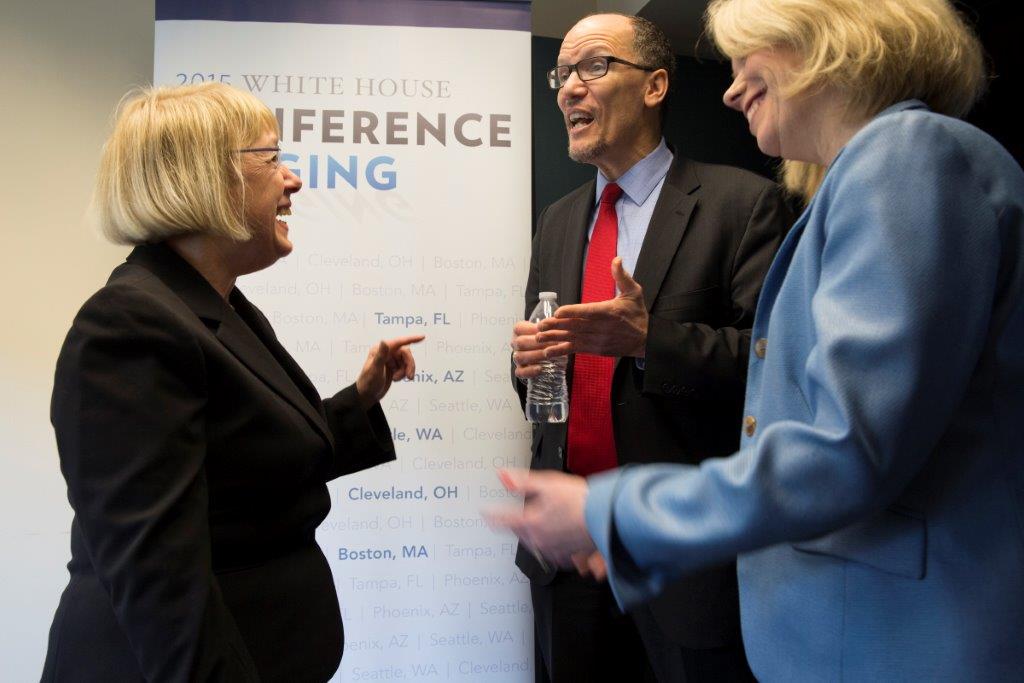Recently, we traveled to Phoenix, Arizona and Seattle, Washington, for the White House Conference on Aging (WHCOA) regional forums. At both events, we heard directly from older Americans, their families, caregivers, advocates, community leaders, and experts on how to best address the current aging landscape.

U.S. Senator Patty Murray, U.S. Secretary of Labor Thomas Perez, and WHCOA Executive Director Nora Super discuss aging issues at WHCOA Seattle Regional Forum
Photo Courtesy of U.S. Dept. of Labor
Our Phoenix participants were welcomed by U.S. Congressman Ruben Gallego (AZ-7) and AARP President Jeannine English, and the forum featured keynotes by Dr. Richard Hodes, Director of the National Institute on Aging (NIA) at the National Institutes of Health, and Wendy Spencer, CEO of the Corporation for National and Community Service. Dr. Hodes’ comments highlighted the exciting research underway at NIH, including studies on Alzheimer’s disease and caregiver support, as well as NIA’s Go4Life campaign, which is an exercise and physical activity campaign for older adults. Wendy Spencer discussed the importance of older adult volunteerism, citing examples and telling moving stories of how Senior Corps volunteers are transforming communities and the lives of individuals of all ages.

Dr. Richard Hodes, Director of the National Institute on Aging, at WHCOA Phoenix Regional Forum
Photo Courtesy of U.S. Dept. of HHS
In Phoenix, participants heard the personal stories of Jan Riggs and Rhonda Hollis, who shared their experiences as an Alzheimer caregiver and senior volunteer, respectively. The Phoenix regional forum was further enhanced by a special exhibit provided by the Arizona Commission of the Arts, and its Director of Arts Learning, Alexandra Nelson. “In the Round,” an exhibit featuring artwork from older artists, was a wonderful—and tangible—symbol of the contributions that older adults can make to our society.
In Seattle, U.S. Labor Secretary Thomas Perez delivered the keynote address highlighting the Administration’s efforts to ensure that Americans experience a retirement that is in keeping with our values as a nation. In particular, Secretary Perez noted the Administration’s MyRA program
https://myra.treasury.gov/ which is helping Americans access options to save for retirement, as well as the Department of Labor’s proposed rule to require financial advisers to put the best interests of their clients above their own financial interests. Secretary Perez also emphasized his ongoing commitment to supporting the healthcare workforce, including the home and community based services workforce. He highlighted the importance of the Olmstead decision in ensuring care and treatment in the most integrated setting and the Department of Labor’s final rule to bring minimum wage and overtime protections to direct care workers.

U.S. Secretary of Labor Thomas Perez speaks at Seattle Regional Forum
Photo Courtesy of U.S. Dept. of Labor
The Seattle forum began with U.S. Senator Patty Murray kicking off the day with a warm welcome to the at-capacity crowd and thoughtful remarks about the opportunities and promise older Americans offer our country. We were also joined by U.S. Congressman Jim McDermott (WA-7); U.S. Congresswoman Suzan DelBene (WA-1); King County Executive Dow Constantine; Deputy Commissioner for Retirement and Disability Policy at the U.S. Social Security Administration, Virginia Reno; and AARP CEO, Jo Ann Jenkins.

Healthy Aging and LTSS panel at WHCOA Seattle Regional Forum
(left to right) Nora Super, WHCOA Executive Director; Charissa Raynor, Executive Director of the SEIU Healthcare Northwest Training Partnership and the Health Care Trust; Bill Moss, Assistant Secretary at the Aging and Long-Term Support Administration, within the Washington State Department of Social and Health Services; Diane Naraski, Executive Director of Asian Counseling and Referral Services; Laura Carstensen, Professor of Psychology and the Farleigh S. Dickinson Jr. Professor in Public Policy at Stanford University
Photo Courtesy of U.S. Dept. of HHS
Following discussions with national, regional and local expert panels, each forum included a number of dynamic breakout sessions where attendees provided input and ideas on the most important issues facing older Americans and possible solutions. In Phoenix, many participants stressed the importance of changing the conversation about aging in America from one that focuses on the limitations of getting older to one that recognizes how the time, talent, and experience of older adults can enrich our communities and enhance older Americans’ health and well-being. In Seattle, participants stressed the importance of Social Security to retirement security. Participants also discussed the growing diversity of older populations and how programs and services should better reflect cultural and language differences.
The forums, co-sponsored by AARP, and co-planned with the Leadership Council of Aging Organizations, were webcast live and we urge everyone who watched to share your comments, thoughts, and ideas on what you heard in the Get Involved section of this website and to tune into our upcoming forums in Cleveland and Boston. Your input will be used to continue to inform the work of this year’s conference. We look forward to hearing from you.
Thank you for your interest in commenting on this blog. At this time, we are no longer accepting comments. If you are still interested in sharing your thoughts, please e-mail them to info@whaging.gov.